Desert Bighorn Sheep
Location and Population
The Desert Bighorn, Ovis canadensis, generally will not be found in areas of human activity. Open terrain with broad vistas and steep boulder-strewn slopes are their preferred habitat. In such areas they may be found from hillsides of only a few hundred feet to over 10,000 feet in some of the highest desert mountains of eastern California, much of Nevada, northwestern Arizona, and southern Utah. Today's total population is roughly 13,000, about 10% of what existed before the settlement of the west.Bighorn Description
Male sheep are called rams. They weigh 140 to 220 pounds and they can be recognized by their large curling set of horns. Their horns will curl back over their ears, down and back up past the cheeks. A mature ram (seven or eight years old) will have a set of horns about 30 inches long and spread about 30 inches wide. The set will weigh about 30 pounds. Even though the size of the horns is a symbol of rank in the herd, many rams will rub off the ends against a rock (brooming) as the ends will tend to interfere with their vision. The shorter horns on a female, called a ewe never extend past half a curl. The ewes are also smaller in size than rams, weighing from 75 to 130 pounds.Hooves for Climbing
Bighorn hooves are sharp-edged and cloven. Elastic and concave they help the sheep move about easily in the rocky terrain they prefer. They have adapted to this type of terrain to escape predators and protect themselves when bedding and lambing. Desert Bighorn can run on level ground at up to 30 miles per hour, and up steep mountain slopes at 15 mph. They can stand comfortably on a ledge as narrow as 2 inches.Diet and Digestion
The bighorn typically use open areas of low growing vegetation near steep, rugged terrain for feeding. They graze and browse a wide variety of plant species including cacti, but green grasses are preferred. Bighorns have a complex digestive process that maximizes removal of nutrients from their food. By passing food from one stomach compartment to another and chewing in between, nutrients are efficiently absorbed and only concentrated dry droppings remain.Diurnal Activity
The Desert Bighorn is mostly active during the daylight and moves to traditional bedding areas before nightfall. In the summer bighorn may sometimes be found above their water sources, resting and chewing their cud in the midday heat. Ewes will seldom venture far from the herd, but rams will wander frequently.Seasonal Activities
In the winter, when green grasses are available, bighorn do not need to drink. However, in the hot summer months, they need to visit waterholes at least every three days. Ewes with nursing lambs need to drink nearly everyday. They can tolerate a reduced body weight of up to 20% as a result of water loss. They often look emaciated when arriving to drink. Within minutes they can replenish the lost water and appear trim and strong. The capacity to drink quickly and replenish lost water is most likely an adaptation to increased predation around water sources. Mountain lions, will wait in the narrow rocky canyons that bighorn use to access water holes and streams.Eyesight
Bighorn have extremely acute eyesight, which helps them spot ledges and footholds when moving about steep terrain. They can spot and watch animals at a distance of nearly a mile away.Bighorn Herds
Like all sheep, bighorn can form herds of over 100 individuals. However, small groups of 8 to 10 are more common. Rams, forming bachelor bands, tend to stay apart from ewes and lambs most of the year, but join them during the mating (rut). During this time, rams will snort loudly, lambs will bleat, and ewes will respond with a "ba-baa" sound.Propagation
Rams will battle over access to particular females during the rut, however, do not defend territories. Overall size, vigor as well as horn size determine male dominance within the herd. Rutting may occur at anytime throughout the year, but seems to peak in August through September. With a gestation period of 150 to 180 days most birthing is done from February to April. Lambs will form bands of their own, seeking their mothers to suckle occasionally. By the time they are six months old, they are completely weaned and living on the same diet as others in the herd.Lifespan
Only about one of three lambs born during the spring will survive the first summer, falling victim to the dangers described as being inherent to bighorn. Ewes will be ready to breed in about the third year. Rams will be ready about the same age but are not usually large enough to compete with older, larger males until they are about seven years old. On the average, Bighorn Sheep live to about 10 years old with a maximum life span of 20 years.Predation
Bighorn Sheep have few enemys. Mountain lions occasionally prey on them. There have been many reports of Coyotes pursuing them, although the impact of this has been minor -- Mostly injured adults or straying lambs having been captured.Majestic Creatures
If you are fortunate enough to see a Bighorn Sheep, you are not likely to forget the muscular body and the massive curling horns. Stationed on a precipitous rocky outcropping or cliff, these majestic creatures are most worthy of any postcard or travel brochure.Competition
At one time, well over one hundred thousand of these existed in an area far larger than the ranges of today. In over eighteen mountain ranges these beautiful animals are now extinct. Although they've adapted well to higher, steeper ground, feral burros and wild horses introduced by the Spanish, and later by Anglo-settlers, still compete for the vegetation the Bighorn Sheep once claimed.Native People and the Bighorn
The southwestern indigenous people hunted the Bighorn and held it in the highest esteem. It was included in their prayers as evidenced throughout petroglyph and pictograph sites. It may have been the Bighorn as a plentiful and nutritious food source that originally brought them into the range. Hunting was more productive than gathering. Preparation of meat was much simpler and faster than gathering and processing seeds and roots. Later, as the availablity of the Bighorn decreased, probably due to human population increases and improved hunting techniques, methods of gathering and the preparation of alternative food sources developed.Source - NPS

View from Bighorn territory

Brooming keeps horns back from eyes

Bighorn hoof-print
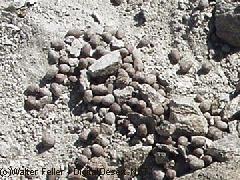
Thorough digestion
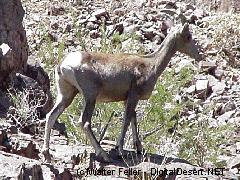
Most active during the day

Bighorn Ewe at water

Exceptional eyesight
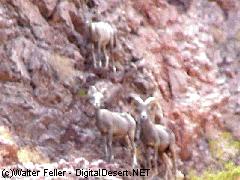
Bachelor Band

Older Bighorn Lamb

Bighorn Ewe
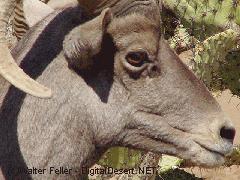
Bighorn Ram
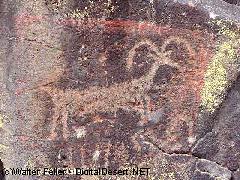
Bighorn Sheep Petroglyph